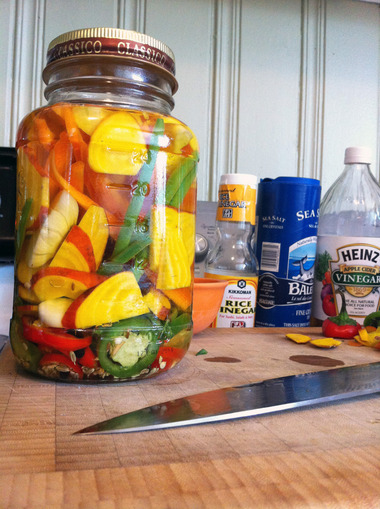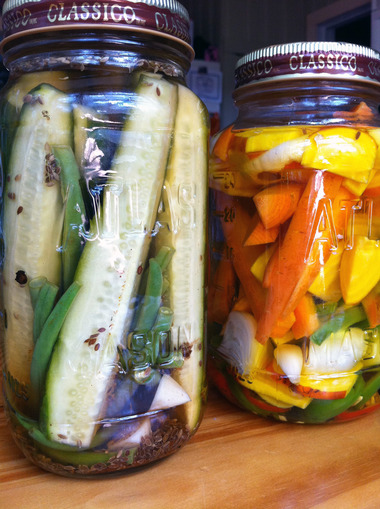Many of you have met me in real life as a result of my pickle evangelism. Now, I have to tell you a little bit about this. I’m a pickle fan, yes, but pickle evangelical? I’ll qualify that by saying how my relationship with my refrigerator has been a long and rocky road. Learning that I could modify any waterbath canning recipe, not only making it smaller, but switching up the vinegar, adding or subbing other kinds of veggies and other off-the-cuff experimentation, all via fridge pickling changed my life.
I’ve gone across the country on the first half of my book tour showing folks how to use up those veggies (before they compost in the crisper drawer). Homemade pickles make great snacks for parties, items to trade at food swaps, or even bestow upon (local) friends as holiday gifts.
Fridge pickles are a type of fresh pickle, but they’re stored in the fridge and not waterbath canned for shelf-storage. The other major branch of pickling involves fermenting (also called brining). Fermented pickles are usually stored in the fridge after they’ve reached the desired level of sourness at a cool-ish room temp of 70-ish degrees F. (Think LES full-sour versus a half-sour. They’re the same pickle, but one is fermented longer.)
Have I lost you already? Don’t worry, there will be no final exam on pickling methods and terminology. The only thing you will be required to do is try a batch of refrigerator pickles.
Here’s the formula for making roughly one quart or two pints of fridge pickles:
1. Wash and cut up your vegetables and pack them into a clean jar. Use whatever veg you’ll eat (or put into a martini): cucumbers, broccoli, cauliflower, Brussels sprouts, carrots, onions, garlic, etc. Weight of your starting produce will vary depending on what you’re pickling. Eyeball it at the market, and if you end up with too little veg, just use a smaller jar (or make more brine to account for extra space in the jar).
It’s up to your palate how to prepare the veggies. I’m a fan of the raw pack (putting the veg in the jar raw), but if you like a more tender, cooked texture, then you can blanch the veggies and/or cook them in the brine (step 3) for a bit to soften them up.
2. Add spices, fresh or dried directly to the jar. For a quart jar, use anywhere between 1/4 and 1/2 tsp of whole dried spices like peppercorns, fennel, cumin, coriander, dill, cloves, or whatever sounds delicious to you.
3. Combine in a medium saucepan and bring to a boil:
- 1 cup any kind of vinegar
- 1 cup filtered water
- 1 Tbs of Kosher or any non-iodized salt
You can add sugar if you like a sweet pickle, but the above is a standard tart pickle recipe. Try starting with 1 tsp sugar; be sure to taste the brine to see if you like it.
4. Pour your just-boiled brine over the vegetables in the jar.
5. Wipe any vinegar spills from the rim with a clean towel or a paper towel and put on the lid. Any lid is fine here since you’re not shelf-sealing the jar, reuse your already used two-piece lids or recycle those single-piece screw lids that once capped salsa, tomato sauce or peanut butter.
6. Now for the hard part. Hide the jar in the back of the fridge for at least a week. Two weeks is better, and three weeks is best. Your pickles will only continue to become more deliciously infused. But if you break into them early, I won’t tell. They’ll keep what seems like forever, but if you have pickle experiments in there from more than 6 months back it’s probably time to do a fridge inventory.
Tips to remember for fridge pickling:
- A regular-mouth jar will be better for pickling since it will help prevent your veggies from all floating to the top once you pour over the brine. Some may still float, but the constriction (vs. the straight-sided wide-mouth jar) is helpful.
- Don’t screw on the lid on as tightly as you possibly can or the lid might pop off when you go to open them in a couple weeks. Vinegar breaking down the veggies inside a jar causes a little release of gas, and leaving the lid loose will let that escape. [I know what you’re wondering and the answer is no. If your pickles have been stored in the fridge, it’s not possible for botulism spores to activate.]
- If you become a pickle evangelical, too, grab some of these plastic lids so your re-usable bands don’t rust.
- Fridge pickling is a one-way equation. Any waterbath canning recipe can be turned into a fridge pickle, but any fridge pickle may NOT be turned into a waterbath-safe recipe.
- My pickle bible is Linda Ziedrich’s The Joy of Pickling; I defer to her excellent flavor ideas when I have a pile of vegetables at my disposal.
- Check out page 230 in my book for a quick and easy just-like-Lower-East-Side dill pickled cucumbers recipe!
Check out these fun recipes from friends:
Marisa’s Asian-Inspired Refrigerator Pickles
Tigress’ White Radish Pickle
Audra’s Pickled Onions for Cocktails

